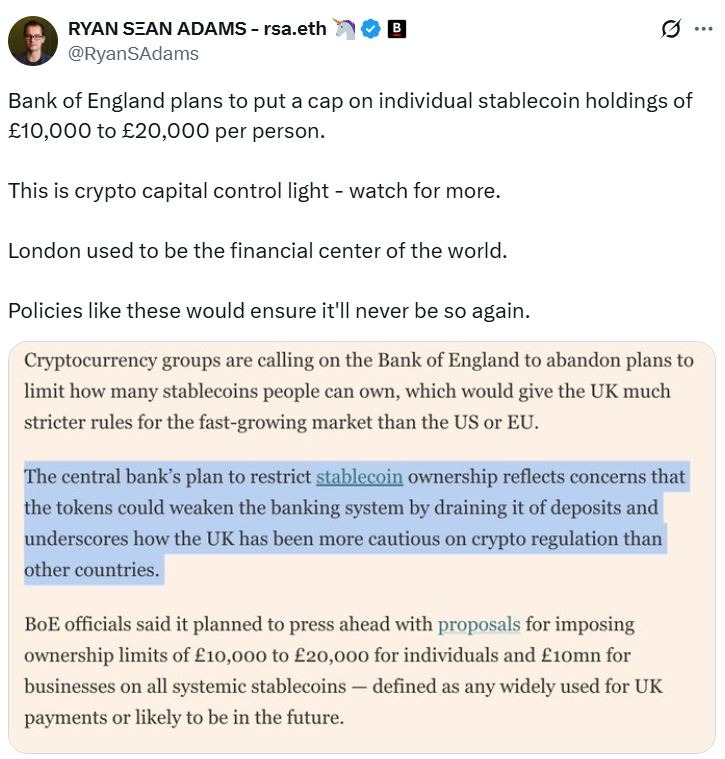
Bank of England's Temporary Stablecoin Limit Plan
The Bank of England's Deputy Governor has reiterated that proposed restrictions on stablecoins will be temporary to maintain system stability, despite industry concerns regarding innovation and growth.
The Deputy Governor of the Bank of England, Sarah Breeden, clarified that the institution’s plan to impose limits on stablecoin holdings and transaction sizes is intended to be a temporary measure aimed at ensuring the stability of the financial system.
Concerns were raised by industry groups regarding these proposed limits on stablecoins, which were initially introduced in a November 2023 discussion document to promote financial stability. As discussions evolved, industry representatives criticized the plans in September, arguing that such restrictions would impede innovation and hinder growth.
In her address at DC Fintech Week, Breeden maintained that the limits were solely meant to serve as a stopgap and would ultimately be lifted as the central bank aims to “support a role for stablecoins in a multi-money system.”
Breeden also emphasized that these measures are designed to facilitate the adjustment of the real economy’s financing structure to stablecoins and to enable the bank to monitor stablecoin adoption and assess potential rapid changes in the financial system structure.
“So let me be clear. We would expect to remove the limits once we see that the transition no longer threatens the provision of finance to the real economy.”
Industry groups have reacted strongly against the proposed limits, which were estimated to be between $13,429 and $26,858 (10,000 and 20,000 British pounds), noting that this could signal to the broader market that the UK does not support crypto ventures, thus discouraging businesses from entering the market.
 Source: Ryan Adams
Source: Ryan Adams
Stablecoin Regulations Still Under Consideration
Breeden mentioned that the Bank of England will initiate a consultation before the year’s end to gather public feedback on the limit levels and implementation strategies.
“We will be consulting in coming weeks on the detail of our proposed regime for sterling stablecoins used in systemic payment systems, and we’ll be open to feedback as we finalize our rules.”
One of the suggestions being discussed is setting higher limits for businesses and exempting supermarkets and major corporations.
Additionally, there are talks of allowing companies within the country’s digital sandbox, established in October 2024 as a testing ground for digital ledger technology, to benefit from certain exemptions.
Concerns About System Adaptability to Stablecoins
According to Breeden, the primary concern of the Bank of England is that rapid withdrawals from traditional banks into stablecoins might cause a steep decline in credit availability for businesses and consumers if the system is unable to cope. She stressed that it is crucial for the financial system to have sufficient time to gradually accommodate these changes, particularly given the dependencies of the UK’s credit system on banks as opposed to other countries like the US.
“Our starting point is that applying limits to a user’s holdings of a given systemic stablecoin is the best way to avoid such a precipitous reduction in the availability of credit to UK borrowers.”
Central Bank’s Role in Asset Market Settlements
Breeden expressed her view that wholesale payments and asset market settlements should remain the responsibility of the central bank, to prevent unnecessary interconnectedness that could create stability risks.
However, she also acknowledged that central bank-backed money is not utilized for all transactions currently and expects this to remain the case, particularly as tokenized markets evolve to include tokenized deposits and regulated stablecoins.
“We can’t, though, do this alone. We need the industry — both incumbents and new entrants — to work with us to engage, to experiment, to develop the use cases, and to deploy this technology.”
Related: UK moves to allow asset managers to use blockchain for fund tokenization


